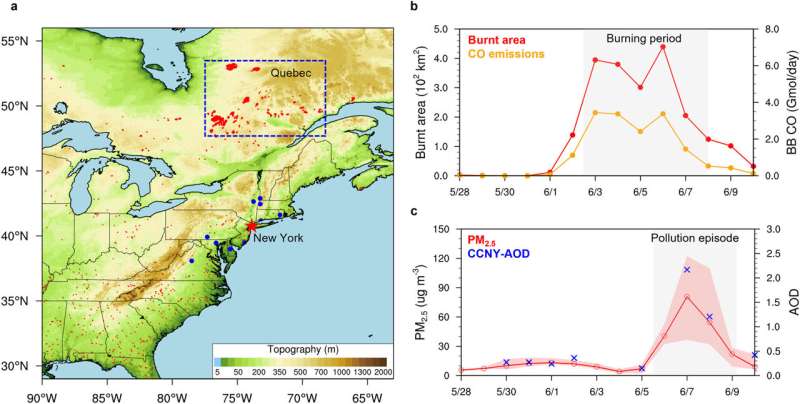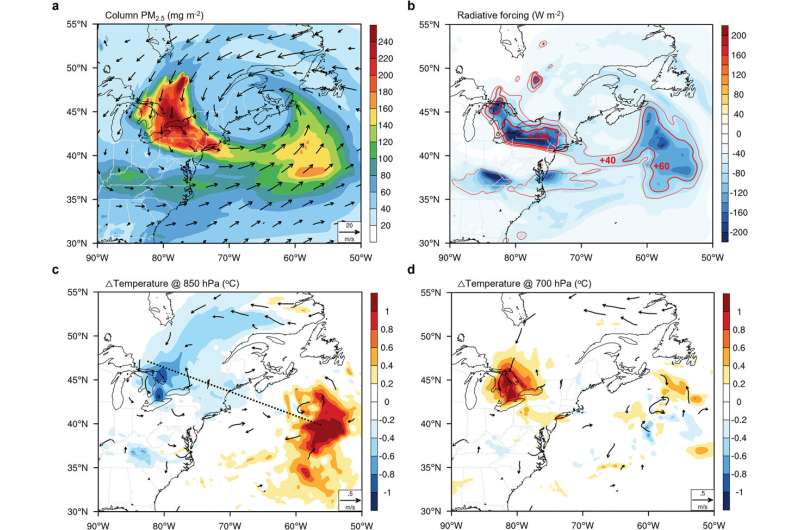July 11, 2024 feature
This article has been reviewed according to Science X's editorial process and policies. Editors have highlighted the following attributes while ensuring the content's credibility:
fact-checked
peer-reviewed publication
trusted source
proofread
Canadian wildfire smoke dispersal worsened by coincident cyclones, study suggests

Wildfires are unplanned and unpredictable threats to Earth; while we may intuitively relate them to extreme heat at lower latitudes, they are known to occur in Arctic regions, such as those recently ravaging Russia.
Such phenomena not only pose hazards to local communities and wildlife through destruction of habits and infrastructure, but also impinge upon regional air pollution to affect public health, as well as impacting incoming solar radiation and albedo feedbacks that link to global temperatures and meteorological cycles.
One such cycle is cyclones, air masses rotating about zones of low pressure, that often bring extreme weather conditions. New research, published in Geophysical Research Letters, has linked intensification of mid-latitude cyclone activity with the occurrence of wildfires and their augmentation effect on wind and cloud formation, focusing on a case study from Canada.
In June 2023, high temperatures and drought led to 200 wildfires sweeping across Quebec's boreal forest in a week-long period, burning >156,000 km2 of land and releasing 1.3 Pg of CO2, degrading air quality in eastern Canada and North America. Indeed, particulate matter concentrations reached 8 times the "safe level" outlined by the World Health Organization.
To analyze this further, Dr. Zilin Wang, of Nanjing University, China, and colleagues input high-resolution records of trace gas and particle emissions from biomass burning, alongside satellite observation of the location and size of wildfires, into simulation software to determine their interactivity with meteorological systems.

The research team identified a strong connection to cyclone activity exacerbating the transport of wildfire smoke southwards across northeast America, reaching as far as New York. The "rear" of the cyclone acted as a bridge to the north and brought the particulate matter downwind, while stagnation of the cyclone (moving at 7.9 km h-1) over two days deepened the aerosol concentration over the affected cities.
Furthermore, they found the change in energy balance in Earth's atmosphere (radiative forcing) to vary considerably between land and ocean, from -150 W m-2 to 100 W m-2. This means smoke aerosols have important consequences for interacting with incoming solar radiation, variably reflecting or absorbing it, causing cooling (by ~1 °C) or warming (by ~0.5 °C) respectively.
This is especially the case for aerosols forming cloud condensation nuclei that increase cloud formation and longevity, and feeds into the enhancement of cyclonic cloud activity. Not only this, but aerosols can impact surface wind speeds, atmospheric moisture and air temperature sufficiently to form a positive feedback loop that exacerbates wildfire activity.
This research is important as the prevalence of wildfires is likely to increase into the future as the climate continues to warm. As such, understanding how smoke aerosols from wildfires affect meteorological systems is of vital importance to help mitigate against the effects of more extreme weather phenomena.
More information: Zilin Wang et al, Intensification of Mid‐Latitude Cyclone by Aerosol‐Radiation Interaction Increases Transport of Canadian Wildfire Smoke to Northeastern US, Geophysical Research Letters (2024). DOI: 10.1029/2024GL108444
Journal information: Geophysical Research Letters
© 2024 Science X Network





















